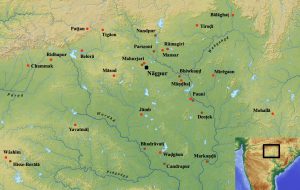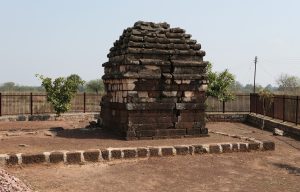
Ancient Vidarbha showing find-spots of Vākāṭaka inscriptions (Zenodo).

Deotek देवटक (Thana नागभीड, District Chandrapur, Maharashtra). Śiva temple of the circa 11th century.
| Metadata | |
|---|---|
| Object ID | OB00142 |
| Title | Deotek Stone Slab |
| Subtitle | |
| Inscription(s) | IN00155 INNAG0032 |
| Child Object | |
| Parent Object | |
| Related Objects | |
| Responsibility | |
| Author | Mirashi, V. V. |
| Metadata recorded by | Dániel Balogh |
| Authority for metadata | |
| Metadata improved by | Dániel Balogh |
| Authoriy for improved | |
| Description | |
| Material | Stone / sandstone |
| Object Type | Stone slab |
| Dimensions: | |
| Width | 275 |
| Height | |
| Depth | 86-106 |
| Weight | |
| Details | The slab is wider at one end and and narrower at the other (an oblong trapezoid). Its height/thickness is not reported. It bears an early inscription (INNAG0032) written lengthwise about the middle region of the top of the slab, and a Vākāṭaka inscription (IN00155) running crosswise, beginning at the narrower end of the stone. Sometime in the course of its history it was converted into a liṅga base (probably when the temple proper was built in the circa 11th century); the socket for the liṅga is next to the Vākāṭaka inscription (i.e. perhaps below its last line, but Mirashi's description is none too clear), and a roughly cut channel was "carried mercilessly" (ASIR 07: 124) through this inscription to drain off oblations. |
| History | |
| Created: | |
| Date | |
| Place | |
| Other ancient history | |
| Found: | |
| Date | 1873-74 |
| Place | Deotek |
| Other modern history | |
| Latest: | |
| Date | 1963 |
| Place | Central Museum, Nagpur |
| Authority | Mirashi, Vasudev Vishnu. (1963). Inscriptions of the Vākāṭakas (Corpus Inscriptionum Indicarum 5). Ootacamund: Archaeological Survey of India. |
| Details | First inscribed allegedly in Mauryan times. ASIR 07: 124 felt that the Vākāṭaka inscription was "cut evidently with some regard for the prior inscription", but Mirashi 1963: 1-2 disagrees, believing that part of the earlier inscription had been chiselled away to make room for the later one. At a yet later stage the slab was converted into a liṅga base. The stone was discovered by J. D. Beglar in 1873-74 in the village of Deoṭek (20.60981, 79.738403), 50 miles southeast of Nagpur. At the time it was in the shade of a magnificent tamarind tree in what had been the sanctum of a wholly ruined small temple, and was a favourite resting spot with locals. A photograph of the site (with a less ruined temple) is available at http://www.bl.uk/onlinegallery/onlineex/apac/photocoll/g/largeimage59252.html. ASIR 07: 125 notes that this type of stone is not found in the vicinity of its findspot, so the stone may have originated elsewhere. |
| Notes | The slab contains two inscriptions, one dating to a post-Aśokan period, and the second to a Vākāṭaka ruler called Rudrasena, although there is some debate over whether this is Rudrasena I or Rudrasena II (Shastri 1997: 4). According to Mirashi, the inscription records the construction of a temple (p. 2) whilst Shastri argues that the inscription records the construction of a ‘court of justice’ (Shastri 1997: 4-5). Both inscriptions refer to the locality of the inscriptions as Chikumburi/Chikkamburi, which suggests that the region flourished from at least the post-Mauryan era to the early Vākāṭaka rule. Shastri states that Hiralal has identified the site of Chikumburi/Chikkamburi with the village of Chikmārā. (Shastri 1997: 5) Although the inscription is not dated, Mirashi states that this is the earliest known Vākāṭaka inscription (p. 3). |